engine YAMAHA V1 2015 Owner's Guide
[x] Cancel search | Manufacturer: YAMAHA, Model Year: 2015, Model line: V1, Model: YAMAHA V1 2015Pages: 94, PDF Size: 3.01 MB
Page 56 of 94
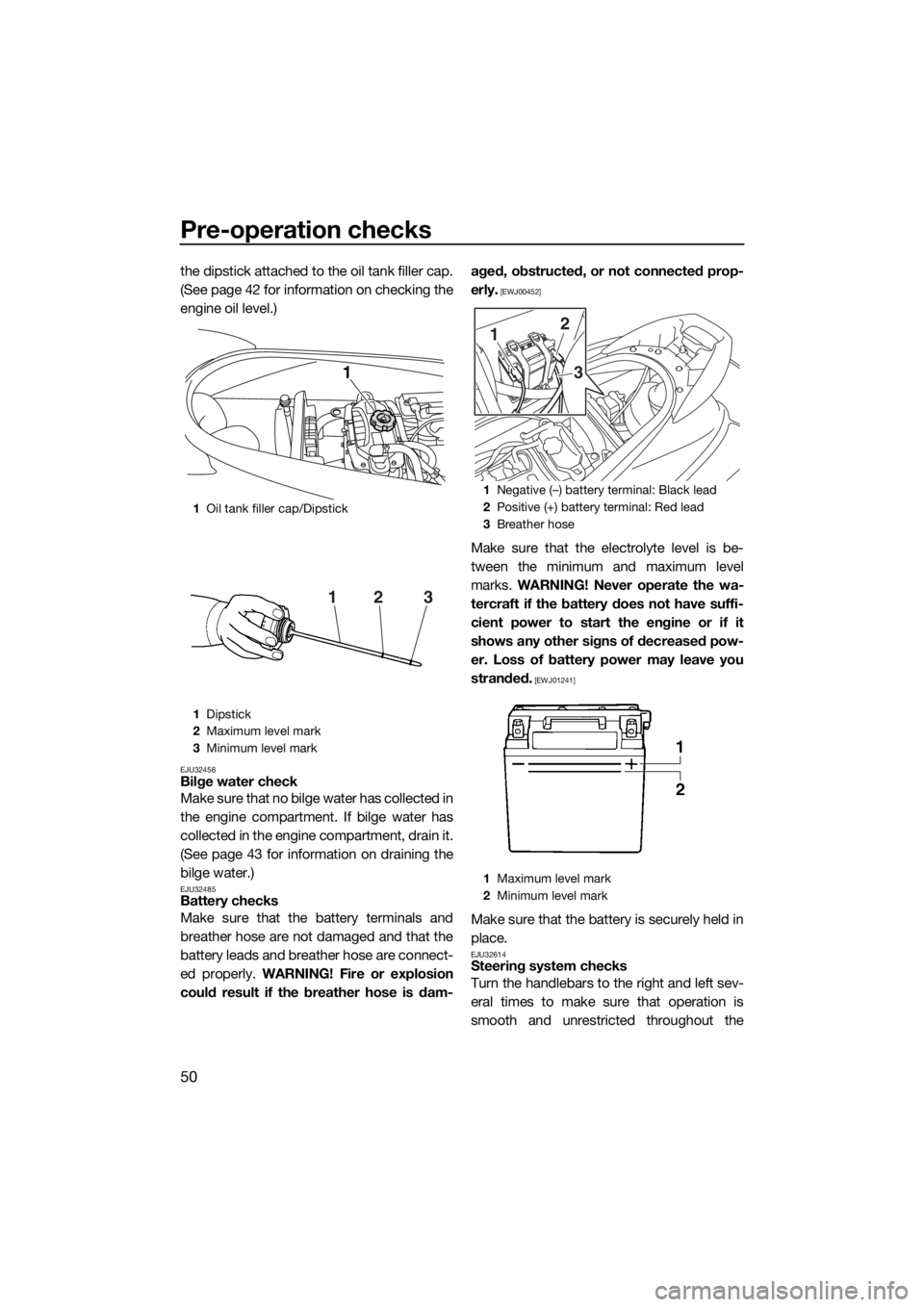
Pre-operation checks
50
the dipstick attached to the oil tank filler cap.
(See page 42 for information on checking the
engine oil level.)
EJU32456Bilge water check
Make sure that no bilge water has collected in
the engine compartment. If bilge water has
collected in the engine compartment, drain it.
(See page 43 for information on draining the
bilge water.)
EJU32485Battery checks
Make sure that the battery terminals and
breather hose are not damaged and that the
battery leads and breather hose are connect-
ed properly. WARNING! Fire or explosion
could result if the breather hose is dam-aged, obstructed, or not connected prop-
erly.
[EWJ00452]
Make sure that the electrolyte level is be-
tween the minimum and maximum level
marks. WARNING! Never operate the wa-
tercraft if the battery does not have suffi-
cient power to start the engine or if it
shows any other signs of decreased pow-
er. Loss of battery power may leave you
stranded.
[EWJ01241]
Make sure that the battery is securely held in
place.
EJU32614Steering system checks
Turn the handlebars to the right and left sev-
eral times to make sure that operation is
smooth and unrestricted throughout the
1Oil tank filler cap/Dipstick
1Dipstick
2Maximum level mark
3Minimum level mark
1
213
1Negative (–) battery terminal: Black lead
2Positive (+) battery terminal: Red lead
3Breather hose
1Maximum level mark
2Minimum level mark
12
3
UF2P72E0.book Page 50 Tuesday, August 26, 2014 10:08 AM
Page 58 of 94
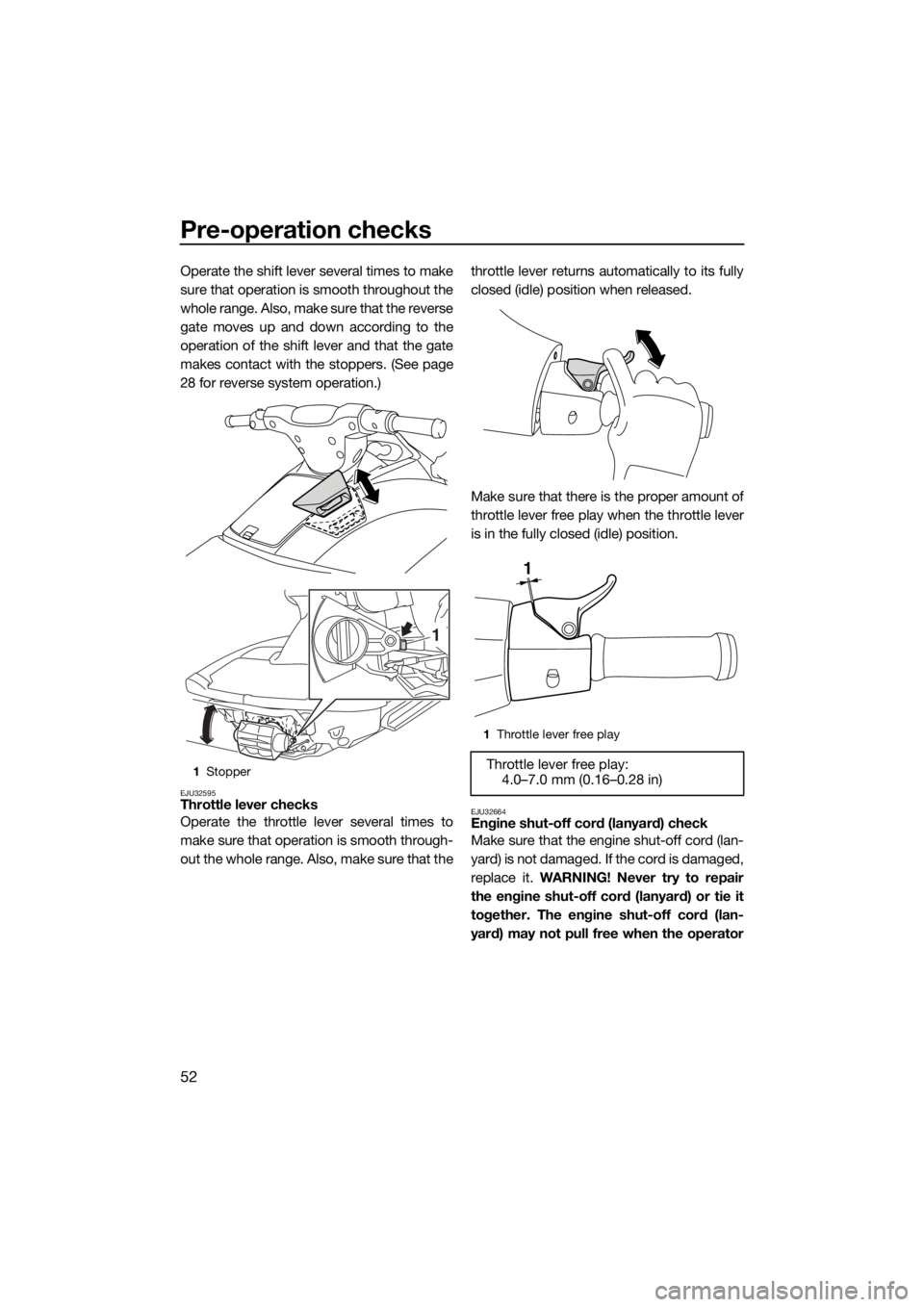
Pre-operation checks
52
Operate the shift lever several times to make
sure that operation is smooth throughout the
whole range. Also, make sure that the reverse
gate moves up and down according to the
operation of the shift lever and that the gate
makes contact with the stoppers. (See page
28 for reverse system operation.)
EJU32595Throttle lever checks
Operate the throttle lever several times to
make sure that operation is smooth through-
out the whole range. Also, make sure that thethrottle lever returns automatically to its fully
closed (idle) position when released.
Make sure that there is the proper amount of
throttle lever free play when the throttle lever
is in the fully closed (idle) position.EJU32664Engine shut-off cord (lanyard) check
Make sure that the engine shut-off cord (lan-
yard) is not damaged. If the cord is damaged,
replace it. WARNING! Never try to repair
the engine shut-off cord (lanyard) or tie it
together. The engine shut-off cord (lan-
yard) may not pull free when the operator
1Stopper
1
1Throttle lever free play
Throttle lever free play:
4.0–7.0 mm (0.16–0.28 in)
1
UF2P72E0.book Page 52 Tuesday, August 26, 2014 10:08 AM
Page 59 of 94
![YAMAHA V1 2015 Owners Guide Pre-operation checks
53
falls off, allowing the watercraft to contin-
ue to run and cause an accident.
[EWJ01221]
EJU40692
Switch checks
NOTICE
ECJ01311
Do not run the engine over 4000 r/min on
land. YAMAHA V1 2015 Owners Guide Pre-operation checks
53
falls off, allowing the watercraft to contin-
ue to run and cause an accident.
[EWJ01221]
EJU40692
Switch checks
NOTICE
ECJ01311
Do not run the engine over 4000 r/min on
land.](/img/51/51943/w960_51943-58.png)
Pre-operation checks
53
falls off, allowing the watercraft to contin-
ue to run and cause an accident.
[EWJ01221]
EJU40692
Switch checks
NOTICE
ECJ01311
Do not run the engine over 4000 r/min on
land. Also, do not run the engine for more
than 15 seconds without supplying water,
otherwise the engine could overheat.
Check the start switch, the engine stop
switch, and the engine shut-off switch for
proper operation. (See pages 25 to 25 for in-
formation on operating each switch.)
To check the operation of the switches:
(1) Push the start switch to make sure that
the engine starts.(2) As soon as the engine starts running,
push the engine stop switch to make
sure that the engine stops immediately.
(3) Restart the engine, and then pull the en-
gine shut-off cord (lanyard) to remove
the clip from the engine shut-off switch
to make sure that the engine stops im-
mediately.
EJU40102Storage compartment checks
Make sure that the storage compartments
are not damaged and that water has not col-
lected in the compartments. (See page 36 for
information on the storage compartments.)
EJU41082Fire extinguisher holder, cover, and band
checks
Make sure that the fire extinguisher holder,
cover, and band are not damaged and that
the cover is securely held in place using the
band. (See page 38 for information on the fire
extinguisher holder, cover, and band.)
EJU32544Fire extinguisher check
Check that there is a full fire extinguisher on
board.
To check the fire extinguisher, see the in-
structions supplied by the fire extinguisher
manufacturer. Always keep the fire extin-
guisher secured in the holder with its cover in
place.
Always carry a fire extinguisher on board. A
fire extinguisher is not standard equipment
1Engine shut-off switch
2Clip
3Start switch
4Engine stop switch
5Engine shut-off cord (lanyard)
123
4
5
UF2P72E0.book Page 53 Tuesday, August 26, 2014 10:08 AM
Page 60 of 94
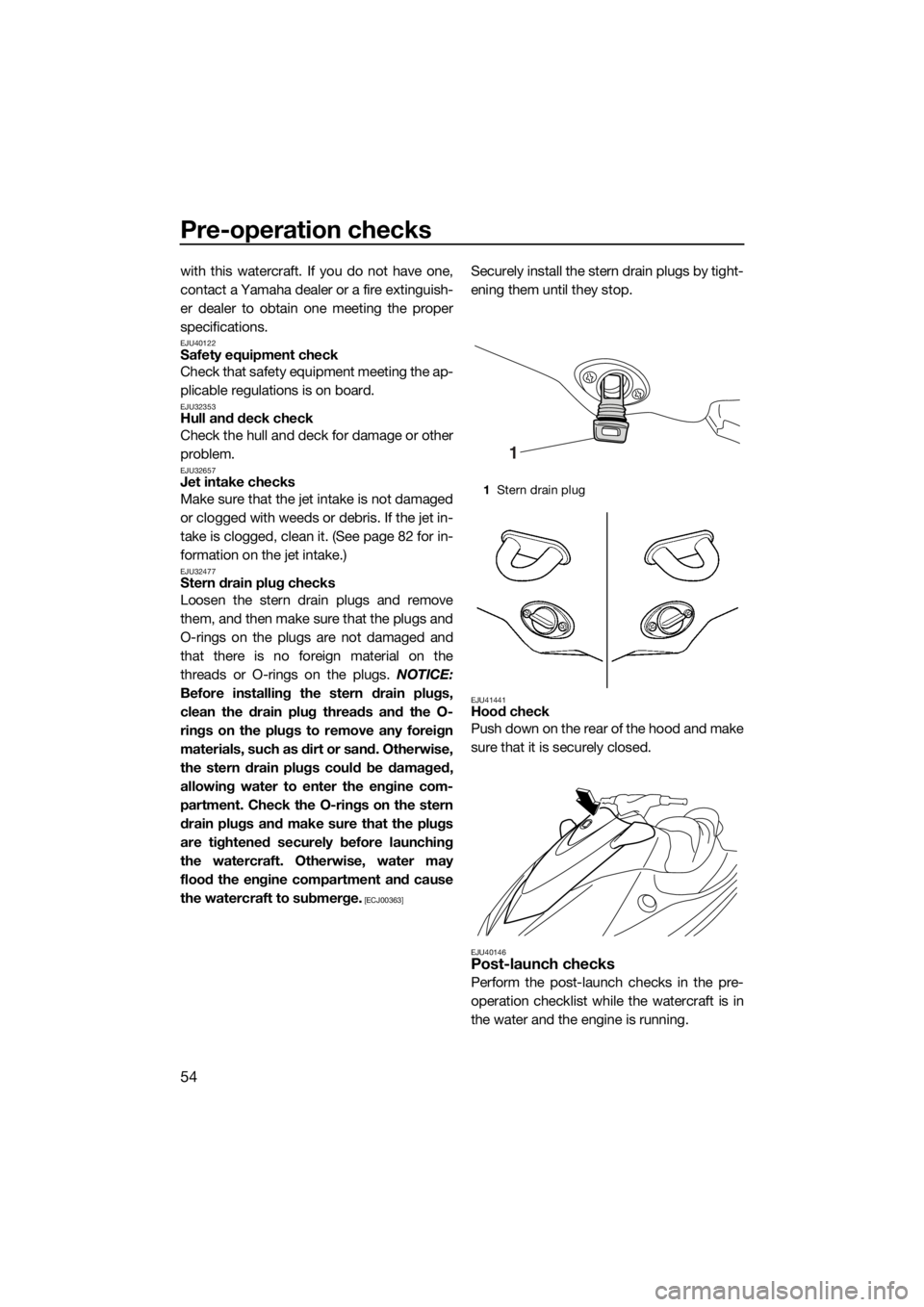
Pre-operation checks
54
with this watercraft. If you do not have one,
contact a Yamaha dealer or a fire extinguish-
er dealer to obtain one meeting the proper
specifications.
EJU40122Safety equipment check
Check that safety equipment meeting the ap-
plicable regulations is on board.
EJU32353Hull and deck check
Check the hull and deck for damage or other
problem.
EJU32657Jet intake checks
Make sure that the jet intake is not damaged
or clogged with weeds or debris. If the jet in-
take is clogged, clean it. (See page 82 for in-
formation on the jet intake.)
EJU32477Stern drain plug checks
Loosen the stern drain plugs and remove
them, and then make sure that the plugs and
O-rings on the plugs are not damaged and
that there is no foreign material on the
threads or O-rings on the plugs. NOTICE:
Before installing the stern drain plugs,
clean the drain plug threads and the O-
rings on the plugs to remove any foreign
materials, such as dirt or sand. Otherwise,
the stern drain plugs could be damaged,
allowing water to enter the engine com-
partment. Check the O-rings on the stern
drain plugs and make sure that the plugs
are tightened securely before launching
the watercraft. Otherwise, water may
flood the engine compartment and cause
the watercraft to submerge.
[ECJ00363]
Securely install the stern drain plugs by tight-
ening them until they stop.
EJU41441Hood check
Push down on the rear of the hood and make
sure that it is securely closed.
EJU40146Post-launch checks
Perform the post-launch checks in the pre-
operation checklist while the watercraft is in
the water and the engine is running.
1Stern drain plug
1
UF2P72E0.book Page 54 Tuesday, August 26, 2014 10:08 AM
Page 61 of 94
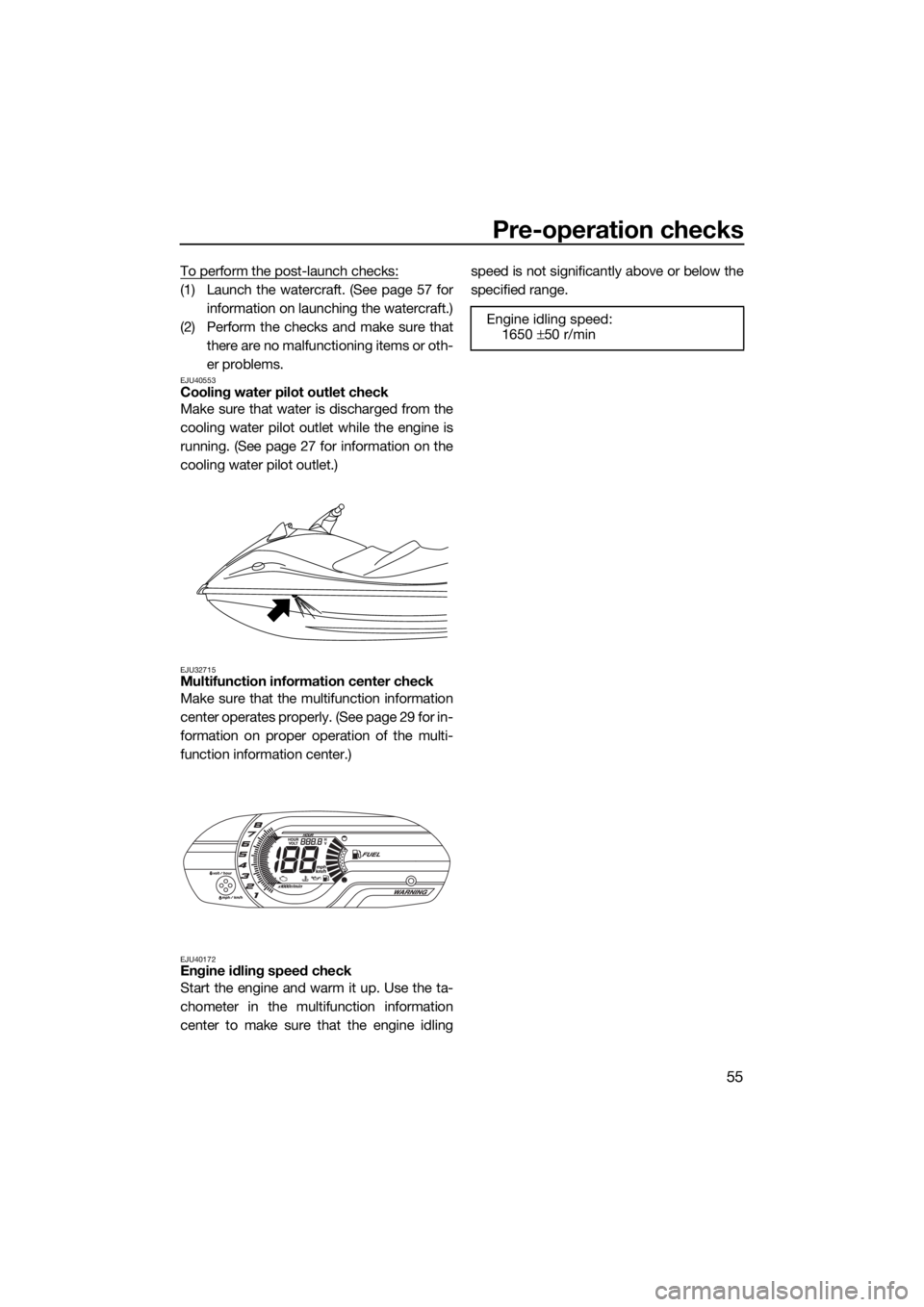
Pre-operation checks
55
To perform the post-launch checks:
(1) Launch the watercraft. (See page 57 for
information on launching the watercraft.)
(2) Perform the checks and make sure that
there are no malfunctioning items or oth-
er problems.
EJU40553Cooling water pilot outlet check
Make sure that water is discharged from the
cooling water pilot outlet while the engine is
running. (See page 27 for information on the
cooling water pilot outlet.)
EJU32715Multifunction information center check
Make sure that the multifunction information
center operates properly. (See page 29 for in-
formation on proper operation of the multi-
function information center.)
EJU40172Engine idling speed check
Start the engine and warm it up. Use the ta-
chometer in the multifunction information
center to make sure that the engine idlingspeed is not significantly above or below the
specified range.
Engine idling speed:
1650 ±50 r/min
UF2P72E0.book Page 55 Tuesday, August 26, 2014 10:08 AM
Page 63 of 94
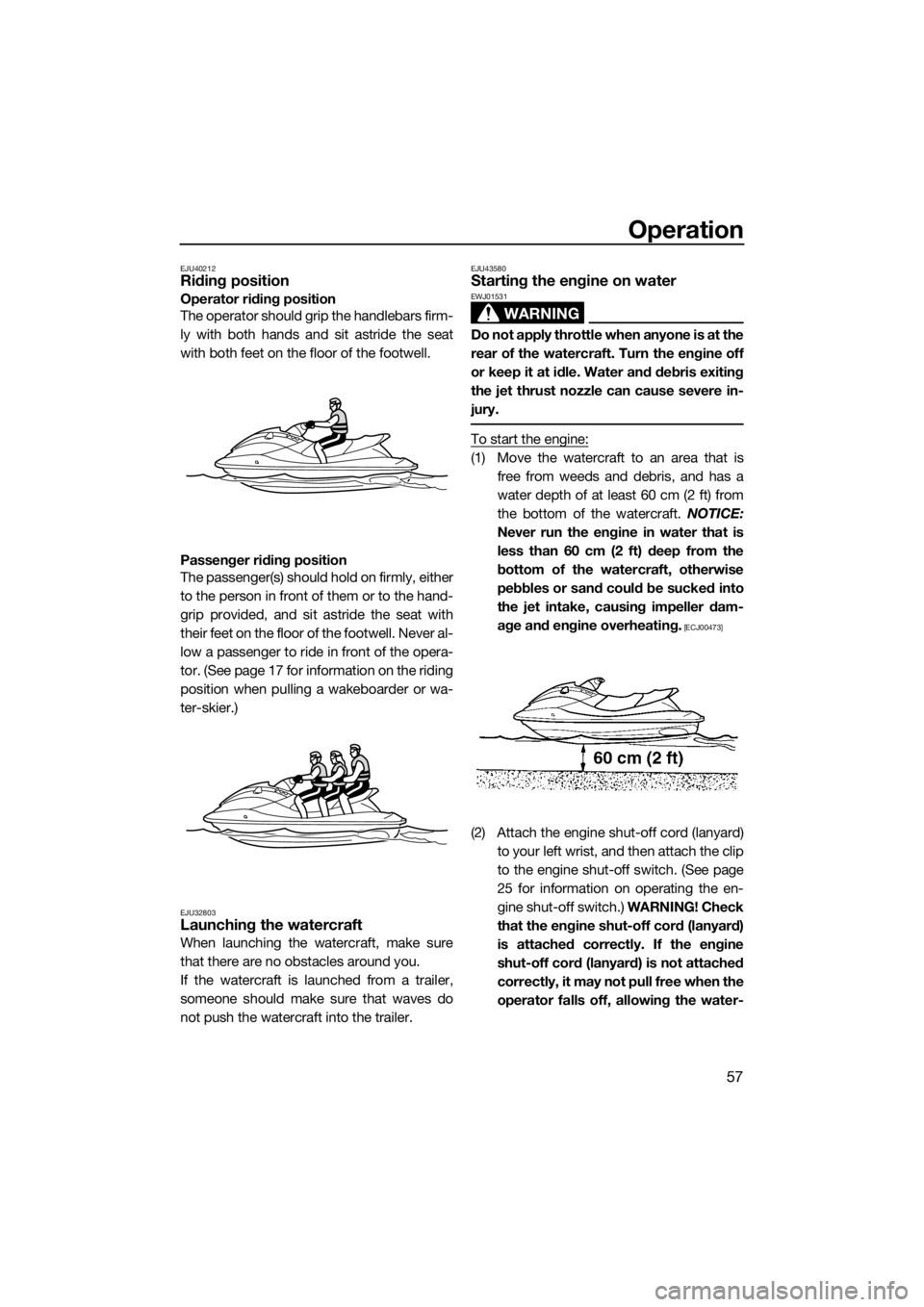
Operation
57
EJU40212Riding position
Operator riding position
The operator should grip the handlebars firm-
ly with both hands and sit astride the seat
with both feet on the floor of the footwell.
Passenger riding position
The passenger(s) should hold on firmly, either
to the person in front of them or to the hand-
grip provided, and sit astride the seat with
their feet on the floor of the footwell. Never al-
low a passenger to ride in front of the opera-
tor. (See page 17 for information on the riding
position when pulling a wakeboarder or wa-
ter-skier.)
EJU32803Launching the watercraft
When launching the watercraft, make sure
that there are no obstacles around you.
If the watercraft is launched from a trailer,
someone should make sure that waves do
not push the watercraft into the trailer.
EJU43580Starting the engine on water
WARNING
EWJ01531
Do not apply throttle when anyone is at the
rear of the watercraft. Turn the engine off
or keep it at idle. Water and debris exiting
the jet thrust nozzle can cause severe in-
jury.
To start the engine:
(1) Move the watercraft to an area that is
free from weeds and debris, and has a
water depth of at least 60 cm (2 ft) from
the bottom of the watercraft. NOTICE:
Never run the engine in water that is
less than 60 cm (2 ft) deep from the
bottom of the watercraft, otherwise
pebbles or sand could be sucked into
the jet intake, causing impeller dam-
age and engine overheating.
[ECJ00473]
(2) Attach the engine shut-off cord (lanyard)
to your left wrist, and then attach the clip
to the engine shut-off switch. (See page
25 for information on operating the en-
gine shut-off switch.) WARNING! Check
that the engine shut-off cord (lanyard)
is attached correctly. If the engine
shut-off cord (lanyard) is not attached
correctly, it may not pull free when the
operator falls off, allowing the water-
UF2P72E0.book Page 57 Tuesday, August 26, 2014 10:08 AM
Page 64 of 94
![YAMAHA V1 2015 Owners Guide Operation
58
craft to continue to run and cause an
accident.
[EWJ00582]
(3) With the throttle lever released, push the
start switch (green button) to start the
engine. (See page 25 for information on YAMAHA V1 2015 Owners Guide Operation
58
craft to continue to run and cause an
accident.
[EWJ00582]
(3) With the throttle lever released, push the
start switch (green button) to start the
engine. (See page 25 for information on](/img/51/51943/w960_51943-63.png)
Operation
58
craft to continue to run and cause an
accident.
[EWJ00582]
(3) With the throttle lever released, push the
start switch (green button) to start the
engine. (See page 25 for information on
operating the start switch.)
EJU32863Stopping the engine
Release the throttle lever, and then push the
engine stop switch (red button) to stop the
engine. WARNING! You need throttle to
steer. Shutting the engine off can cause
you to hit an obstacle you are attemptingto avoid. A collision could result in severe
injury or death.
[EWJ00602]
EJU32873
Leaving the watercraft
If leaving the watercraft, remove the clip from
the engine shut-off switch to prevent acci-
dental starting or unauthorized operation by
children or others.
EJU41573Operating the watercraft
V1:
When the engine is running, the watercraft
will move forward at trolling speed even if the
1Clip
2Engine shut-off switch
3Engine shut-off cord (lanyard)
12
3
STARTSTOP
UF2P72E0.book Page 58 Tuesday, August 26, 2014 10:08 AM
Page 65 of 94

Operation
59
throttle lever is in the fully closed (idle) posi-
tion.
V1 Sport:
When the shift lever is in the forward position
and the engine is running, the watercraft will
move forward. The watercraft will move for-
ward at trolling speed even if the throttle lever
is in the fully closed (idle) position. (See page28 for information on operating the shift le-
ver.)
EJU33255Turning the watercraft
WARNING
EWJ00772
Do not release the throttle lever when
trying to steer away from objects—you
need throttle to steer. A collision could
result in severe injury or death.
When operating at higher speeds, make
gradual turns or slow down before turn-
ing. Sharp high-speed turns may cause
the watercraft to slide sideways or spin,
throwing the operator and passenger(s)
overboard, which could cause an injury.
Steering control depends on the combination
of handlebar position and the amount of
throttle.
1Shift lever
2Forward position
1
2
UF2P72E0.book Page 59 Tuesday, August 26, 2014 10:08 AM
Page 66 of 94
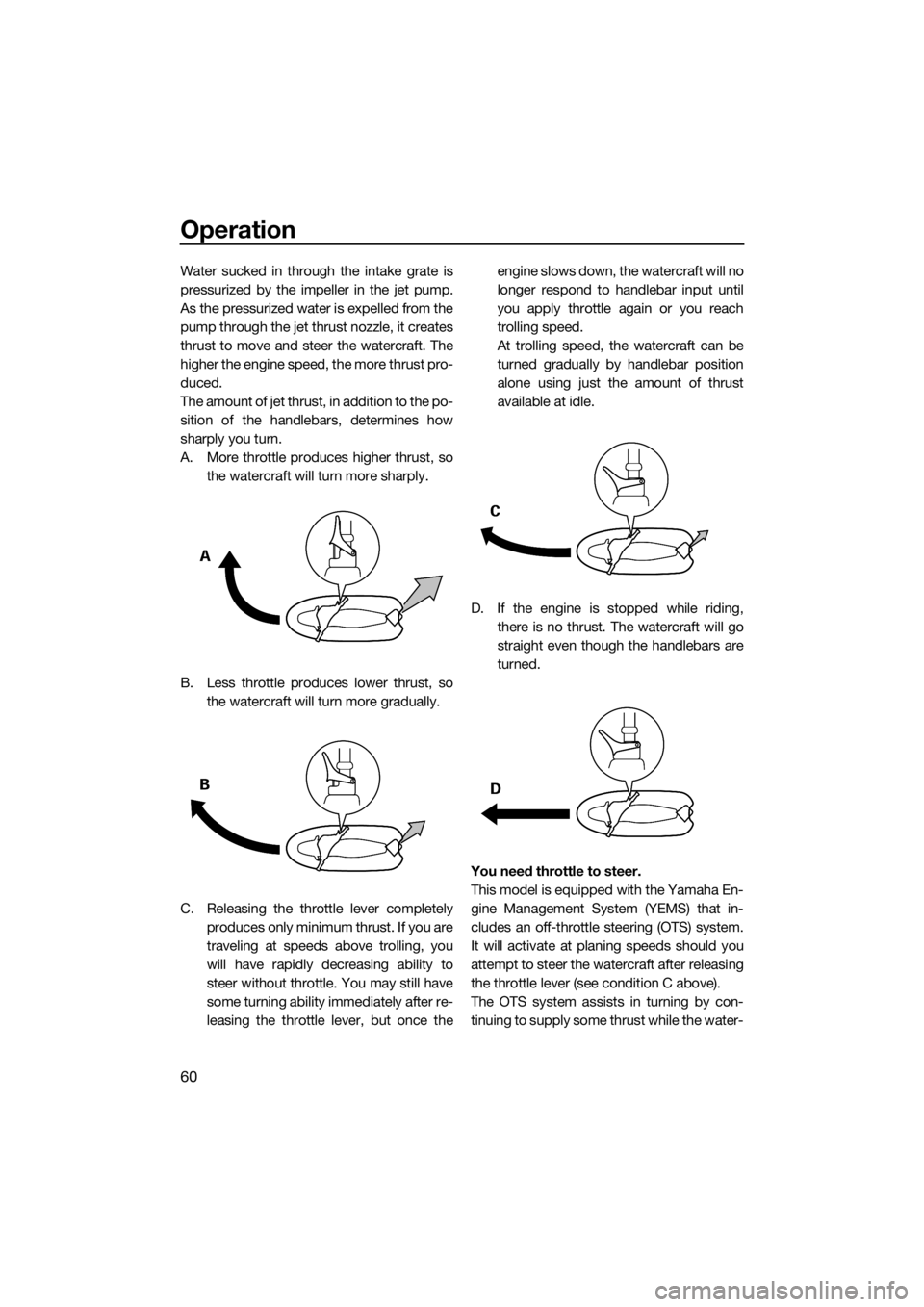
Operation
60
Water sucked in through the intake grate is
pressurized by the impeller in the jet pump.
As the pressurized water is expelled from the
pump through the jet thrust nozzle, it creates
thrust to move and steer the watercraft. The
higher the engine speed, the more thrust pro-
duced.
The amount of jet thrust, in addition to the po-
sition of the handlebars, determines how
sharply you turn.
A. More throttle produces higher thrust, so
the watercraft will turn more sharply.
B. Less throttle produces lower thrust, so
the watercraft will turn more gradually.
C. Releasing the throttle lever completely
produces only minimum thrust. If you are
traveling at speeds above trolling, you
will have rapidly decreasing ability to
steer without throttle. You may still have
some turning ability immediately after re-
leasing the throttle lever, but once theengine slows down, the watercraft will no
longer respond to handlebar input until
you apply throttle again or you reach
trolling speed.
At trolling speed, the watercraft can be
turned gradually by handlebar position
alone using just the amount of thrust
available at idle.
D. If the engine is stopped while riding,
there is no thrust. The watercraft will go
straight even though the handlebars are
turned.
You need throttle to steer.
This model is equipped with the Yamaha En-
gine Management System (YEMS) that in-
cludes an off-throttle steering (OTS) system.
It will activate at planing speeds should you
attempt to steer the watercraft after releasing
the throttle lever (see condition C above).
The OTS system assists in turning by con-
tinuing to supply some thrust while the water-
UF2P72E0.book Page 60 Tuesday, August 26, 2014 10:08 AM
Page 67 of 94
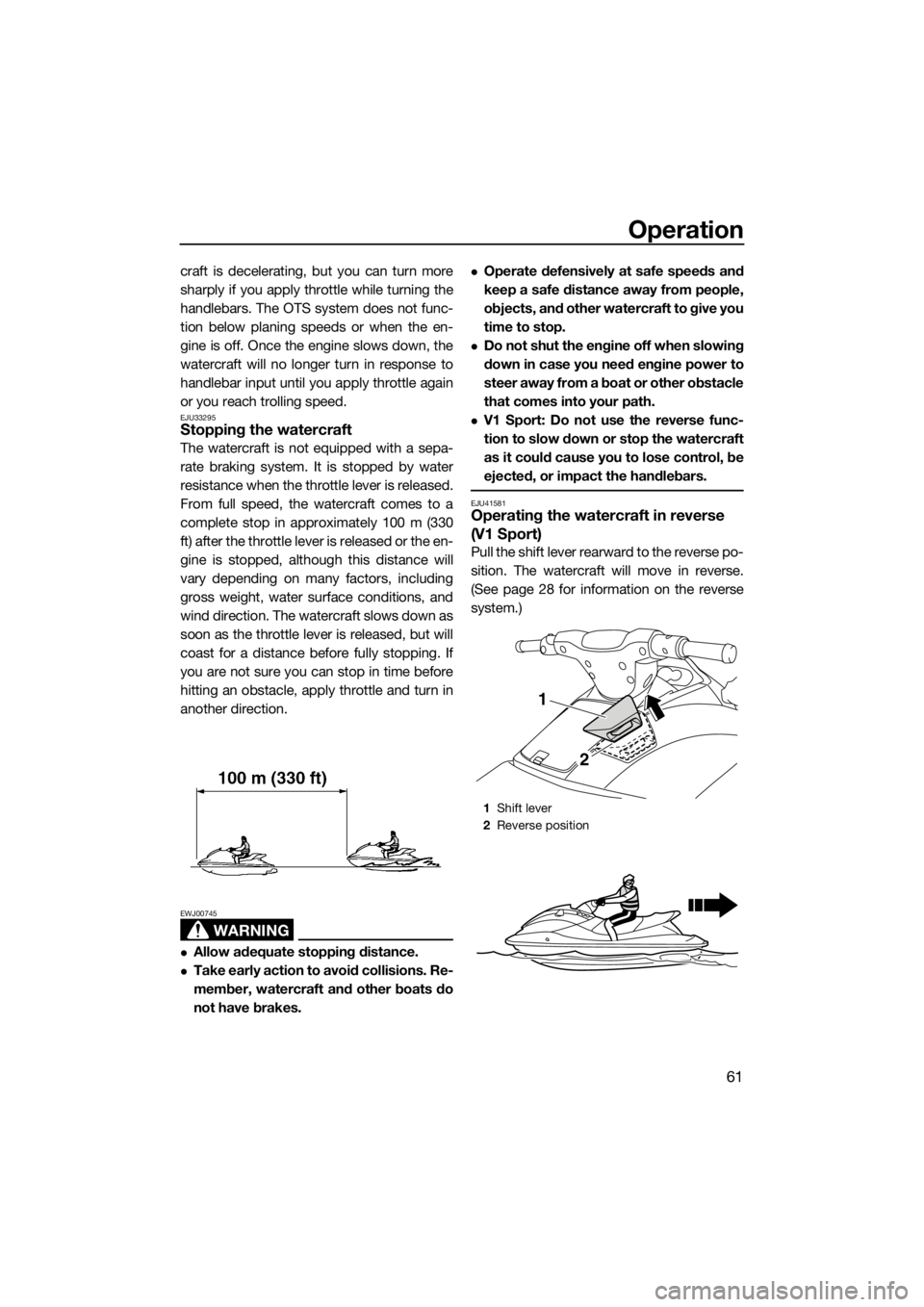
Operation
61
craft is decelerating, but you can turn more
sharply if you apply throttle while turning the
handlebars. The OTS system does not func-
tion below planing speeds or when the en-
gine is off. Once the engine slows down, the
watercraft will no longer turn in response to
handlebar input until you apply throttle again
or you reach trolling speed.
EJU33295Stopping the watercraft
The watercraft is not equipped with a sepa-
rate braking system. It is stopped by water
resistance when the throttle lever is released.
From full speed, the watercraft comes to a
complete stop in approximately 100 m (330
ft) after the throttle lever is released or the en-
gine is stopped, although this distance will
vary depending on many factors, including
gross weight, water surface conditions, and
wind direction. The watercraft slows down as
soon as the throttle lever is released, but will
coast for a distance before fully stopping. If
you are not sure you can stop in time before
hitting an obstacle, apply throttle and turn in
another direction.
WARNING
EWJ00745
Allow adequate stopping distance.
Take early action to avoid collisions. Re-
member, watercraft and other boats do
not have brakes.
Operate defensively at safe speeds and
keep a safe distance away from people,
objects, and other watercraft to give you
time to stop.
Do not shut the engine off when slowing
down in case you need engine power to
steer away from a boat or other obstacle
that comes into your path.
V1 Sport: Do not use the reverse func-
tion to slow down or stop the watercraft
as it could cause you to lose control, be
ejected, or impact the handlebars.
EJU41581Operating the watercraft in reverse
(V1 Sport)
Pull the shift lever rearward to the reverse po-
sition. The watercraft will move in reverse.
(See page 28 for information on the reverse
system.)
1Shift lever
2Reverse position
1
2
UF2P72E0.book Page 61 Tuesday, August 26, 2014 10:08 AM